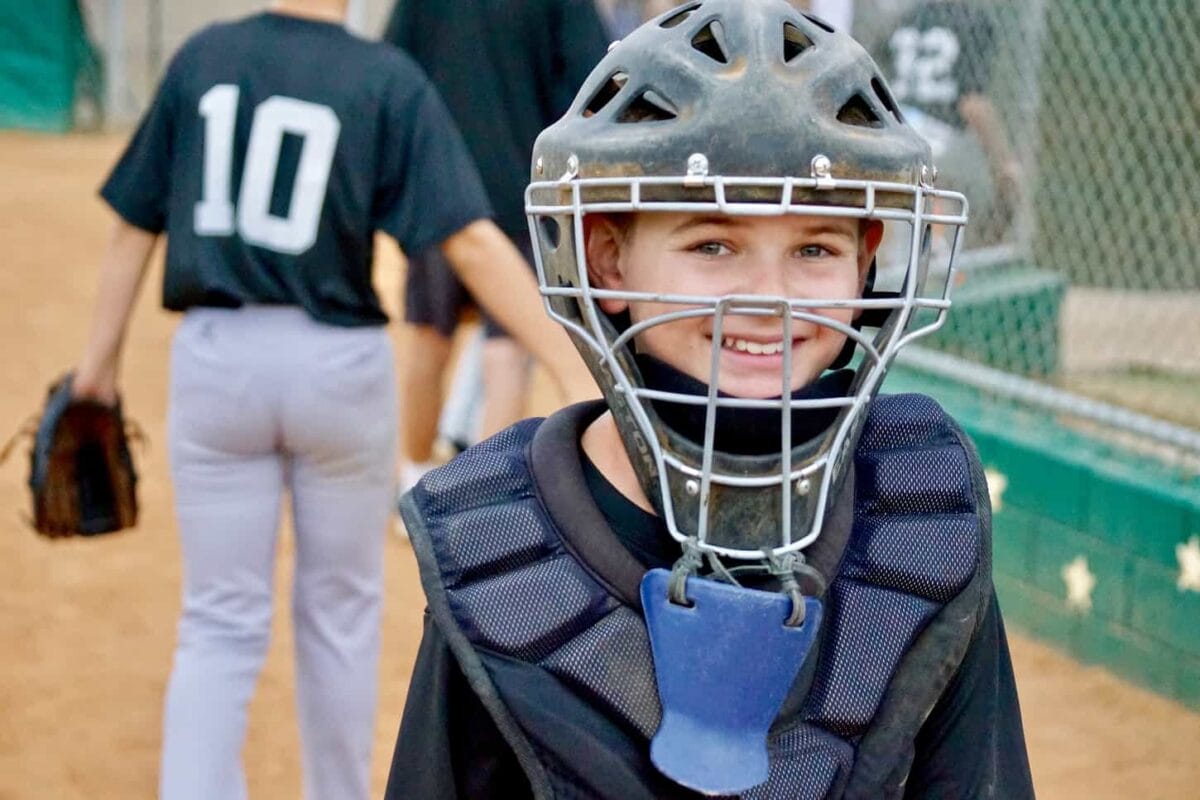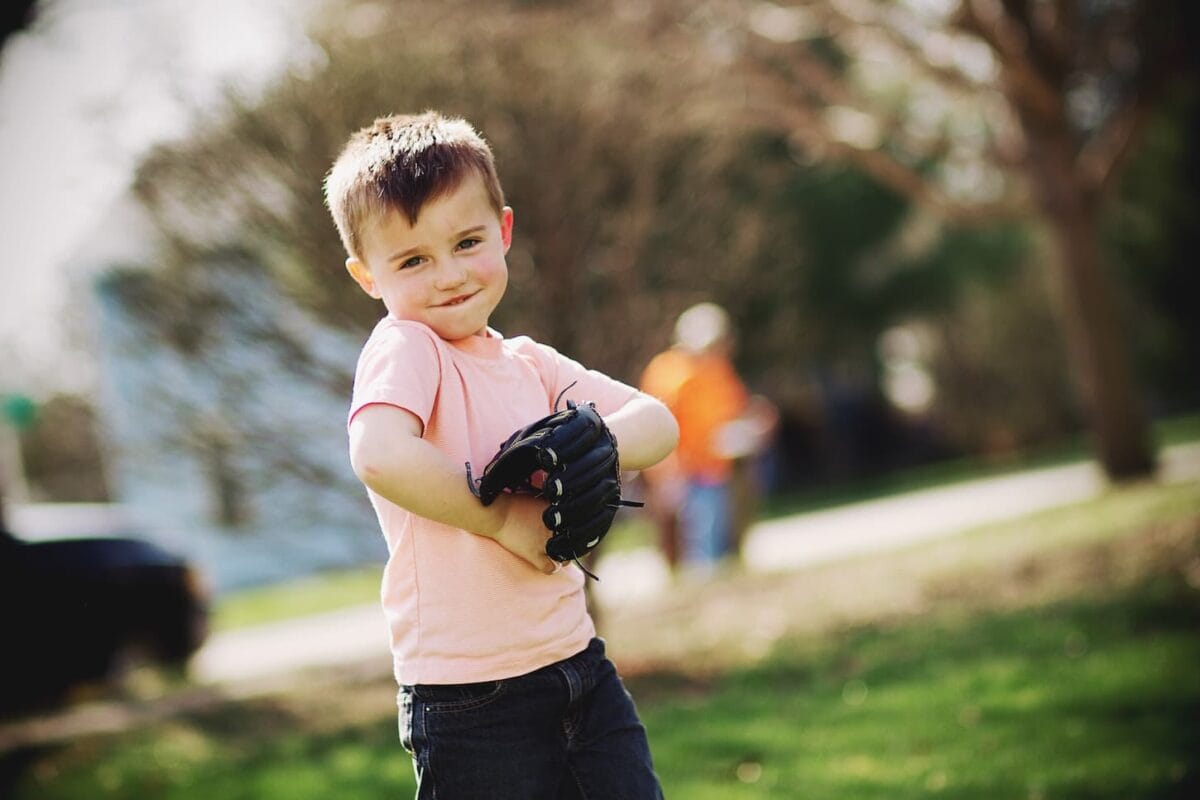Whether a child aspires to be the next Ken Griffey, Jr. or wants to have fun playing catch, many parents want to teach their children to catch a baseball. However, catching a baseball may not come naturally. So, what is the best way to help a child master the perfect catch?
The keys to helping a kid catch a baseball are to help them overcome their fear, watch the ball, learn to use the mitt properly, and get used to catching with their non-dominant hand. Teaching strategies should provide a challenge while allowing the child to experience success.
Teaching our children to catch a baseball can be a fun and rewarding experience for us. So, let’s dive into this article and learn all the how-tos.

Here’s How to Teach Children to Catch a Baseball
Start by teaching children to catch with their non-dominant hand. Next, help the child break in their glove and learn to catch with that. Ensure they catch with the glove’s webbing, not the central part. Aim the ball higher than the child on their glove side so they can catch it easily.
Before having the child catch the ball, it’s good to have them practice the glove’s opening and closing motions. The next step is to have them catch a thrown ball; it’s best to hold off on the bat to reduce nervousness and ensure a positive experience. Start with having them catch underhand throws so they can gain confidence before moving to catch overhand throws.
Catching the ball is about the preparation as much as the act.
- The child should have a well-broken-in glove and be easy to manipulate.
- Wearing the glove with the last two fingers of their hand in the same section can make catching it easier, especially for smaller children.
- They must also learn the proper catching stance, with the glove held front and center.
- The child will be wearing the glove on their non-dominant hand, whether right or left-handed, as they need their dominant hand free for throwing. Learning to catch this way can be the biggest challenge for some children.
With this hand, it can help them practice catching other objects, like bean bags or frisbees, to help them be more adept and comfortable using it.
How do you help a visual learner catch a baseball?
Visual learners understand concepts best by seeing them. For a child with this learning style, it could help to have another adult pitch to the parent so they can watch them catch. They could also benefit from watching pros catch in videos or live games.
To help a visual learner, an adult can demonstrate the motion and then have them repeat it or act it out simultaneously while watching. These children may also benefit from visualizing catching the ball off the field.
How do you help an auditory learner catch a baseball?
Children who prefer auditory learning need to be talked through things. They might do best with step-by-step instructions on how to position their body when catching a ball and continued verbal feedback throughout the learning process.
Metaphors that compare catching to other, more familiar actions could help an auditory learner “get it.” They may also find it helpful to verbalize what they are doing to their instructor and receive confirmation or correction.
How do you help a kinesthetic learner catch a baseball?
Kids who learn best by doing have a kinesthetic learning style. Muscle memory is crucial for anyone trying to learn to catch a baseball, especially for these children. Physically moving their body through the action of catching can be a great teaching method.
This can involve helping adjust their posture, guiding their hand through the opening and closing gestures, and more. Watching someone catch or listen to instructions might not be helpful for these children; they need hands-on experience to figure things out.

When Can You Teach a Child to Catch a Baseball?
The age at which kids learn baseball depends on personality and skill level. Catching an overhead-thrown baseball is challenging for young children. Kids learn baseball the easiest and fastest by learning skills that build on each, graduating to higher skills when they have skill and confidence.
First, the child learns to stop a ball rolling toward them by reaching their arms and pulling it into their body. Then they can transition to catching a thrown ball in open hands. Start with underhand throws, then transition to lightly-thrown overhand balls.
They can use a baseball mitt to catch underhand, then overhand pitches as they age. For younger kids, it is best to use lighter, softer balls, while older children can catch real baseballs.
How can I help my toddler catch a baseball?
Once a child is old enough to sit up, they can start learning the motor skills that will help them catch a baseball when they are older. Rolling a large, soft ball toward a toddler is a great way to get a head start on learning to catch a baseball without throwing an actual baseball at them.
How can I help teach my preschool child (ages 3-5) to catch a baseball?
Preschool-age children can transition to catching a thrown ball—something small but soft, like a tennis ball, is ideal. Children can work on an upward-facing “basket catch” at this age, either with a mitt or with their bare hands.
If the child is starting to use a baseball mitt at this age, they must learn to use it properly. They should know not to catch with the palm of the mitt and spend time practicing the opening and closing motions necessary for catching a baseball.
How can I help my school-aged child (ages 6-12) catch a baseball?
Children can practice throwing and catching a ball as they develop better motor skills and confidence. This is a helpful way to get used to catching different kinds of throws. Older school-age kids can start catching underhand throws with their gloves pointed forward.
Depending on the child’s skill level, this age can be a good time to stop aiming all the throws where they will be easiest to catch. The child has to learn how to go after the ball to catch it, so it can be good to incorporate some randomly placed throws into practice.
How can I help my teenager catch a baseball?
Teenagers can start catching a real baseball in underhand and overhand pitches and start catching a ball that is batted toward them, depending on their skill and confidence. A pitch-back net can be a helpful tool for solo practice and learning to stop ground balls.
If your teenager hasn’t played baseball before, start with more basic skills and work up to actual game-playing skills. This way, they’ll have all the foundational work to be solid players. This will also give them the skills and confidence to do well. Just do it without patronizing or treating them like they’re still 3.
If your teenager already has the foundations of catching and throwing, you can start with game-playing skills, like catching a ball hit from a bat, grounders, and other skills.
Extended practice drills are important for teens who want to play baseball seriously. They need to learn how to catch a wide variety of pitches and get used to exercising the muscles involved with catching for long periods.

How Do You Teach a Scared Kid to Catch a Baseball?
Many children are uncomfortable having an object fly toward them quickly. The human instinct in this situation is to flinch away, but of course, this makes catching the ball difficult. Practice, skill, and confidence are required to overcome this instinct to avoid flying objects.
Starting with softer, lighter objects, such as tennis balls, wiffle balls, or even bean bags, can help children learn to face their fears. It is also important to keep throws gentle and aim them carefully.
A single accident can significantly increase a child’s nervousness or even make them refuse to keep practicing. Successfully catching the ball will help them grow confident and overcome their fear.
Make sure to target practice and teaching techniques to a child’s current level of skill and development. They may become discouraged and insecure if they struggle because they are being asked to do something outside their ability. Start small and build up. Go slow – it’ll be worth it in the long run.
Best Products for Teaching a Kid to Catch a Baseball
Here are some recommended, well-reviewed products that can help teach a child to catch a baseball and get ready to play (and love) the game.
Best Mitts
- Youngest Players: Baseball mitts for young children come in many fun colors, which can help make the game fun.
- School-aged Players: Young kids’ baseball mitts, with right and left-hand versions available. These also come in a lot of great color choices.
- Kids on Teams: As kids age, the color becomes less important than the mitt quality. Here’s a great baseball mitt for older kids and young teens of great quality (while still coming in various colors).
Here are some other great products for players of all ages.
- Keep some tennis balls (like these) on hand to practice throwing and catching with younger kids – or help experienced players develop a stronger arm and higher confidence level.
- A pitching net (or rebounder) like this can help you practice many skills, including throwing and catching.
Want to know if you can re-purpose soccer gear? Read our article, Can Soccer Cleats be Used for Baseball?

Key Takeaways and Next Steps
Catching a baseball can be difficult for children. They may be frightened by the ball, catching can feel unnatural, and using their non-dominant hand takes adjustment. However, parents can help their children grow into confident catchers.
Any child with interest in playing baseball needs to learn to catch a ball—it’s a skill required regardless of their position on a team. The more practice children get with catching a baseball, the more successful they will be.
In turn, this experience of success helps calm their nerves and increase their skill, leading to further success.
To bring this about, parents can use manageable, bite-size training steps for each stage of childhood. Early on, this can involve helping the child get the basic idea of stopping an object’s motion by rolling a ball on the floor.
As the child gets older, they can start practicing simple, upward-facing catches. They should also start getting used to the grasping motion needed to catch a ball in a baseball mitt.
Part of the difficulty is using their non-dominant hand, so doing various activities involving that hand can be a helpful drill.
- A tennis ball thrown by the child or parent makes a good practice object at this stage. Practice in a safe environment with soft objects thrown gently can help the child overcome the natural fear of the ball that could cause them to dodge it instead of catching it.
- For older school-age children and teens, the key is getting a variety of different kinds of practice. They can branch out to forward-facing catches of underhand pitches, overhand pitches, batted balls, and perhaps even ground balls from a pitch-back net.
- For older kids, this is also the stage to teach them to go after the ball instead of waiting for it to be thrown to its exact spot.
At every stage, from toddler to teen, there is room for a child to learn how to catch a baseball and keep improving those skills. With their parents informed and prepared to help them, they might be MVPs.
Resources
Learning from your own experiences is important, but learning from others is also smart. These are the sources used in this article and our research to be more informed as a family of sports nuts wannabes.
- Basham, R. (2017, September 14). Tips and drills for teaching kids to catch a baseball. Baseball Made Fun. https://baseballmadefun.com/tips-and-drills-for-teaching-kids-to-catch-a-baseball/
- Crosby, J. (2018, May 9). How to teach a kid to catch with a baseball glove. Fatherly. https://www.fatherly.com/play/how-to-teach-a-kid-to-catch-with-a-baseball-glove
